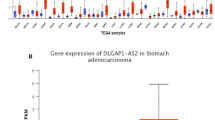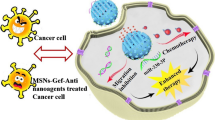Abstract
Background
Sufentanil combined with parecoxib sodium is a commonly used postoperative medication for cancer patients. However, the effects of this combination therapy on human epidermal growth factor receptor-2 (HER2)-positive breast cancer cells have still remained elusive. This study aimed to investigate the effects and potential mechanisms of sufentanil combined with parecoxib sodium on HER2-positive breast cancer cells.
Methods
The cell counting kit-8 (CCK-8), colony formation, flow cytometry, scratch, transwell invasion, and angiogenesis assays were used to assess the proliferation, cell cycling, migration, invasion, and angiogenesis of HER2-positive breast cancer BT474 cells. Western blot assay was employed for detecting the expression levels of proteins involved in the cell cycle, migration, invasion, angiogenesis, and epithelial-mesenchymal transition (EMT). The in vivo effects of tumor growth and metastasis were examined by establishing an orthotopic transplantation mouse model of HER2-positive breast cancer (MMTV-PyMT).
Results
Functional assays indicated that sufentanil combined with parecoxib sodium induced blockade of HER2-positive breast cancer BT474 cells in the G1 phase of the cell cycle and inhibited cell proliferation, migration, angiogenesis, and invasion in vitro. Western blot assay revealed that sufentanil combined with parecoxib sodium downregulated the expression levels of cyclin D1, matrix metalloproteinase-9 (MMP-9), cyclooxygenase-2 (COX-2), vascular endothelial growth factor A (VEGFA), and EMT-related proteins (N-cadherin, Vimentin, and Snail), while up-regulated the expression level of E-cadherin in BT474 cells. In addition, it was found that sufentanil combined with parecoxib sodium inhibited tumor growth and metastasis in the orthotopic transplantation mouse model of HER2-positive breast cancer.
Conclusion
Sufentanil combined with parecoxib sodium inhibited HER2-positive breast cancer progression, including cell proliferation, cell cycle, migration, invasion, and angiogenesis, and regulated EMT.






Similar content being viewed by others
Data availability
The datasets generated during and/or analyzed during the current study are available from the corresponding author on reasonable request.
References
Sung H, Ferlay J, Siegel RL, Laversanne M, Soerjomataram I, Jemal A, Bray F (2021) Global Cancer Statistics 2020: GLOBOCAN estimates of incidence and Mortality Worldwide for 36 cancers in 185 countries. Cancer J Clin 71(3):209–249. https://doi.org/10.3322/caac.21660
Martínez-Sáez O, Prat A (2021) Current and future management of HER2-Positive metastatic breast Cancer. JCO Oncol Pract 17(10):594–604. https://doi.org/10.1200/OP.21.00172
Mahvi DA, Liu R, Grinstaff MW, Colson YL, Raut CP (2018) Local Cancer recurrence: the Realities, Challenges, and Opportunities for New Therapies. Cancer J Clin 68(6):488–505. https://doi.org/10.3322/caac.21498
Galon J, Pages F, Marincola FM et al (2012) Cancer classification using the immunoscore: a worldwide task force. J translational Med 10:205. https://doi.org/10.1186/1479-5876-10-205
Tavare AN, Perry NJ, Benzonana LL, Takata M, Ma D (2012) Cancer recurrence after surgery: direct and indirect effects of anesthetic agents. Int J Cancer 130(6):1237–1250. https://doi.org/10.1002/ijc.26448
Gottschalk A, Sharma S, Ford J, Durieux ME, Tiouririne M (2010) Review article: the role of the perioperative period in recurrence after cancer surgery. Anesth Analg 110(6):1636–1643. https://doi.org/10.1213/ANE.0b013e3181de0ab6
Scroope CA, Singleton Z, Hollmann MW, Parat MO (2021) Opioid receptor-mediated and non-opioid receptor-mediated roles of opioids in Tumour Growth and Metastasis. Front Oncol 11:792290. https://doi.org/10.3389/fonc.2021.792290
Bovill JG (2010) Surgery for cancer: does anesthesia matter? Anesth Analg 110(6):1524–1526. https://doi.org/10.1213/ANE.0b013e3181d8d183
Ramirez MF, Rangel FP, Cata JP (2022) Perioperative pain, analgesics and cancer-related outcomes: where do we stand? Pain Manage 12(2):229–242. https://doi.org/10.2217/pmt-2021-0070
Horowitz M, Neeman E, Sharon E, Ben-Eliyahu S (2015) Exploiting the critical perioperative period to improve long-term cancer outcomes. Nat Rev Clin Oncol 12(4):213–226. https://doi.org/10.1038/nrclinonc.2014.224
Zorrilla-Vaca A, Ripolles-Melchor et al (2022) Association between enrollment in an enhanced recovery program for colorectal cancer surgery and long-term recurrence and survival. J Surg Oncol 125(8):1269–1276. https://doi.org/10.1002/jso.26836
Saito Y, Shimada et al (2013) Regulatory T cells in the blood: a new marker of surgical stress. Surg Today 43(6):608–612. https://doi.org/10.1007/s00595-013-0517-5
Shi H, Chen X, Liu X, Zhu H, Yu F, Ung C, Chan WS, Hu H, Han S (2021) National drug utilization trend of analgesics in China: an analysis of procurement data at 793 public hospitals from 2013 to 2018. J Pharm Policy Pract 14(1):45. https://doi.org/10.1186/s40545-021-00325-8
Martinez L, Ekman E, Nakhla N (2019) Perioperative Opioid-sparing strategies: utility of conventional NSAIDs in adults. Clin Ther 41(12):2612–2628. https://doi.org/10.1016/j.clinthera.2019.10.002
Jiang H, Wang H, Zou W, Hu Y, Chen C, Wang C (2019) Sufentanil impairs autophagic degradation and inhibits cell migration in NCI-H460 in vitro. Oncol Lett 18(6):6829–6835. https://doi.org/10.3892/ol.2019.10997
Chipollini J, Alford et al (2018) Epidural anesthesia and cancer outcomes in bladder cancer patients: is it the technique or the medication? A matched-cohort analysis from a tertiary referral center. BMC Anesthesiol 18(1):157. https://doi.org/10.1186/s12871-018-0622-5
Forget P, Tombal et al (2011) Do intraoperative analgesics influence oncological outcomes after radical prostatectomy for prostate cancer? Eur J Anaesthesiol 28(12):830–835. https://doi.org/10.1097/EJA.0b013e32834b7d9a
Wang RD, Zhu JY, Zhu Y, Ge YS, Xu GL, Jia WD (2020) Perioperative analgesia with parecoxib sodium improves postoperative pain and immune function in patients undergoing hepatectomy for hepatocellular carcinoma. J Eval Clin Pract 26(3):992–1000. https://doi.org/10.1111/jep.13256
Wan Z, Chu C, Zhou R, Que B (2021) Effects of Oxycodone Combined with Flurbiprofen Axetil on Postoperative Analgesia and Immune function in patients undergoing Radical Resection of Colorectal Cancer. Clin Pharmacol drug Dev 10(3):251–259. https://doi.org/10.1002/cpdd.818
Feng X, Lin SQ, Chen Y, Wu XJ (2007) Nan fang yi ke da xue xue bao = Journal. South Med Univ 27(10):1567–1569
Guo JG, Zhao et al (2018) Novel multimodal analgesia regimen improves post-TACE pain in patients with hepatocellular carcinoma. Hepatobiliary & pancreatic diseases international: HBPD INT 17(6):510–516. https://doi.org/10.1016/j.hbpd.2018.08.001
Doornebal CW, Klarenbeek et al (2013) A preclinical mouse model of invasive lobular breast cancer metastasis. Cancer Res 73(1):353–363. https://doi.org/10.1158/0008-5472.CAN-11-4208
Bundscherer A, Malsy et al (2015) Effects of ropivacaine, bupivacaine and sufentanil in colon and pancreatic cancer cells in vitro. Pharmacol Res 95–96. https://doi.org/10.1016/j.phrs.2015.03.017
Ferreira T, Campos et al (2019) The Cyclooxigenase-2 inhibitor parecoxib prevents epidermal dysplasia in HPV16-Transgenic mice: Efficacy and Safety Observations. Int J Mol Sci 20(16):3902. https://doi.org/10.3390/ijms20163902
Xiang L, Klemcke HG, Wienandt NA, Ryan KL, Hinojosa-Laborde C (2018) A novel rat model of extremity trauma for prehospital pain management research. J trauma acute care Surg 85(1S Suppl 2):S49–S56. https://doi.org/10.1097/TA.0000000000001833
Tang H, Li C, Wang Y, Deng L (2021) Sufentanil Inhibits the Proliferation and Metastasis of Esophageal Cancer by Inhibiting the NF-κB and Snail Signaling Pathways. Journal of oncology, 2021, 7586100. https://doi.org/10.1155/2021/7586100
Peng Y, Yang et al (2020) Sufentanil postoperative analgesia reduce the increase of T helper 17 (Th17) cells and FoxP3 + regulatory T (Treg) cells in rat hepatocellular carcinoma surgical model: a randomised animal study. BMC Anesthesiol 20(1):212. https://doi.org/10.1186/s12871-020-01129-0
Li LY, Xiao J, Liu Q, Xia K (2017) Parecoxib inhibits glioblastoma cell proliferation, migration and invasion by upregulating miRNA-29c. Biology open 6(3):311–316. https://doi.org/10.1242/bio.021410
Mondaca JM, Guijarro A, Flamini MI, Sanchez AM (2021) Heregulin-induced cell migration is prevented by trastuzumab and trastuzumab-emtansine in HER2 + breast cancer. Breast Cancer Res Treat 186(2):363–377. https://doi.org/10.1007/s10549-020-06089-0
Duivenvoorden HM, Spurling A, O’Toole SA, Parker BS (2018) Discriminating the earliest stages of mammary carcinoma using myoepithelial and proliferative markers. PLoS ONE 13(7):e0201370. https://doi.org/10.1371/journal.pone.0201370
Yang SJ, Wang et al (2021) Tumor-derived exosomal circPSMA1 facilitates the tumorigenesis, metastasis, and migration in triple-negative breast cancer (TNBC) through miR-637/Akt1/β-catenin (cyclin D1) axis. Cell Death Dis 12(5):420. https://doi.org/10.1038/s41419-021-03680-1
Kolapalli SP, Sahu et al (2021) RNA-Binding RING E3-Ligase DZIP3/hRUL138 stabilizes cyclin D1 to Drive Cell-Cycle and Cancer Progression. Cancer Res 81(2):315–331. https://doi.org/10.1158/0008-5472.CAN-20-1871
Zhu X, Li J, Ning H, Yuan Z, Zhong Y, Wu S, Zeng JZ (2021) α-Mangostin induces apoptosis and inhibits metastasis of breast Cancer cells via regulating RXRα-AKT signaling pathway. 12:739658. Frontiers in pharmacologyhttps://doi.org/10.3389/fphar.2021.739658
Seto-Tetsuo F, Arioka et al (2021) DIF-1 inhibits growth and metastasis of triple-negative breast cancer through AMPK-mediated inhibition of the mTORC1-S6K signaling pathway. Oncogene 40(37):5579–5589. https://doi.org/10.1038/s41388-021-01958-4
Saponaro C, Fanizzi et al (2022) Downstream Signaling of Inflammasome Pathway affects patients’ outcome in the context of distinct molecular breast Cancer subtypes. Pharmaceuticals (Basel Switzerland) 15(6):651. https://doi.org/10.3390/ph15060651
Irawan C, Cahyanur R, Lisnawati L, Abdullah M, Yunus RE (2020) The difference in the cyclin D1 expression in Advanced Stage Nasopharyngeal Cancer based on treatment response: a retrospective cohort study. Acta Med Indones 52(2):147–154
Filipits M, Dafni U, Gnant M et al (2018) Association of p27 and cyclin D1 expression and benefit from Adjuvant Trastuzumab Treatment in HER2-Positive early breast Cancer: a TransHERA study. Clin cancer research: official J Am Association Cancer Res 24(13):3079–3086. https://doi.org/10.1158/1078-0432.CCR-17-3473
Du Y, Zhang et al (2022) Hypoxia-induced ebv-circLMP2A promotes angiogenesis in EBV-associated gastric carcinoma through the KHSRP/VHL/HIF1α/VEGFA pathway. Cancer Lett 526:259–272. https://doi.org/10.1016/j.canlet.2021.11.031
Hamidi H, Ivaska J (2018) Every step of the way: integrins in cancer progression and metastasis. Nat Rev Cancer 18(9):533–548. https://doi.org/10.1038/s41568-018-0038-z
Li M, Yan T, Cai Y, Wei Y, Xie Q (2023) Expression of matrix metalloproteinases and their association with clinical characteristics of solid tumors. Gene 850:146927. https://doi.org/10.1016/j.gene.2022.146927
Pastushenko I, Blanpain C (2019) EMT Transition States during Tumor Progression and Metastasis. Trends Cell Biol 29(3):212–226. https://doi.org/10.1016/j.tcb.2018.12.001
Tong D, Liu et al (2018) The roles of the COX2/PGE2/EP axis in therapeutic resistance. Cancer Metastasis Rev 37(2–3):355–368. https://doi.org/10.1007/s10555-018-9752-y
Acknowledgements
This study was financially supported by the Natural Science Foundation of Ningxia Province (Grant No. 2021AAC03399). The funding agency was not involved in the design of the study and collection, analysis, and interpretation of data, and in writing the manuscript.
Author information
Authors and Affiliations
Corresponding author
Ethics declarations
Conflict of interest
The authors declare that there is no conflict of interest.
Additional information
Publisher’s note
Springer Nature remains neutral with regard to jurisdictional claims in published maps and institutional affiliations.
Rights and permissions
Springer Nature or its licensor (e.g. a society or other partner) holds exclusive rights to this article under a publishing agreement with the author(s) or other rightsholder(s); author self-archiving of the accepted manuscript version of this article is solely governed by the terms of such publishing agreement and applicable law.
About this article
Cite this article
Xu, S., Li, X., Li, W. et al. Sufentanil combined with parecoxib sodium inhibits proliferation and metastasis of HER2-positive breast cancer cells and regulates epithelial-mesenchymal transition. Clin Exp Metastasis 40, 149–160 (2023). https://doi.org/10.1007/s10585-023-10199-6
Received:
Accepted:
Published:
Issue Date:
DOI: https://doi.org/10.1007/s10585-023-10199-6




